Developed at the height of the Japanese automotive industry’s economic boom, the Toyota Sera was an innovative, supermini-size coupe built for the home market between 1990 and 1995. With its glassy canopy and dramatic gull-wing doors the Sera looked incredibly futuristic when compared to its contemporaries; the reason for which can be traced back to the Toyota AXV-II concept car.
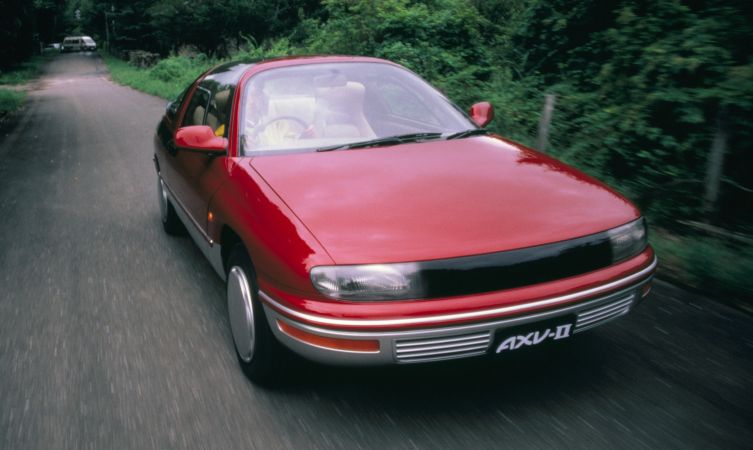
The AXV-II (above) was one of eleven special display vehicles Toyota prepared for the 1987 Tokyo Motor Show. Although it was advertised as an experiment designed to anticipate automobiles and technologies of the next decade, the AXV-II was actually close to being production ready. Enough, in fact, for Toyota to invite selected members of the Japanese motoring press to test drive the concept in advance of the show.
After a few design tweaks, the AXV-II went into production a little over two years later, with the first examples reaching customers in March 1990. The futuristic nature of the new Toyota was reflected in its name, Sera, which is the future tense of the French word etre (to be). According to the official press release of 8 March 1990, the name was chosen “to signify a dream-like car that takes us into the future.”
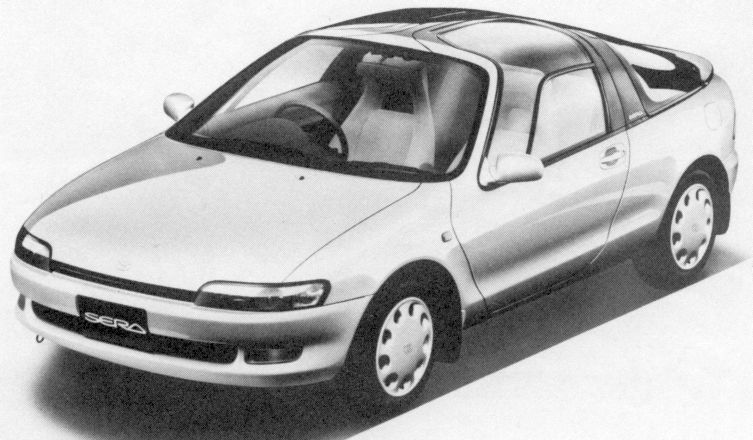
Interestingly, the new Toyota Sera delivered more than just a future aesthetic; it also introduced new techniques to the Toyota Production System. The front wing, for example, was produced using a new flexible press system specifically designed for low volume manufacturing. The technology allowed Toyota to reduce the five conventional panel forming processes – drawing, trimming, bending, cam trimming and cam flanging – to just three. Amazingly, this revolutionary simplification of the press manufacturing process yielded body panels of superior quality and accuracy.
The new Toyota Sera (known internally by its EXY10 chassis code) shared many mechanical components with the closely related Starlet model. But it was differentiated by a wealth of standout features, the headline element of which was, of course, those unusual doors.
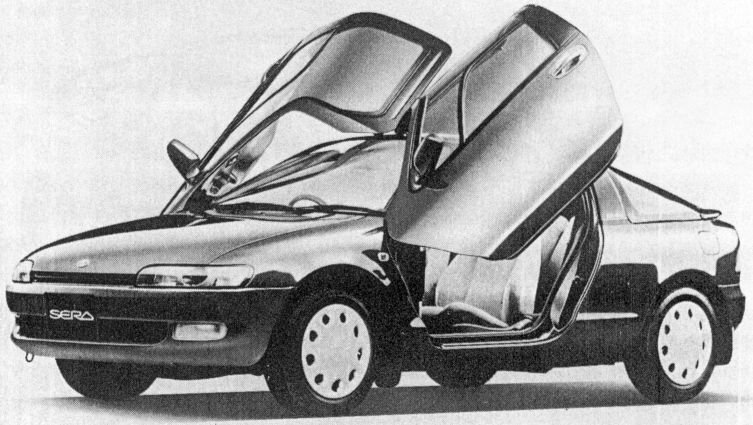
This was the first time that such a gull-wing design had ever been seen on a mass-produced Japanese car, and it apparently inspired Gordon Murray’s development of the McLaren F1 supercar. Each door was hinged in two locations – above the windscreen and at the base of the A-pillar – and that dihedral geometry allowed it to fully open in a more confined space than a traditional side hinge arrangement. Dual, asymmetric gas struts were installed in the doors to maintain consistent operating effort regardless of outside temperature changes.
Even when both doors were closed, the Sera’s wrap-around, all-glass cabin gave occupants the feeling of space, as if they were observing the world through a spherical bubble. However, the resulting solar load meant that air conditioning and power windows were included as standard equipment.
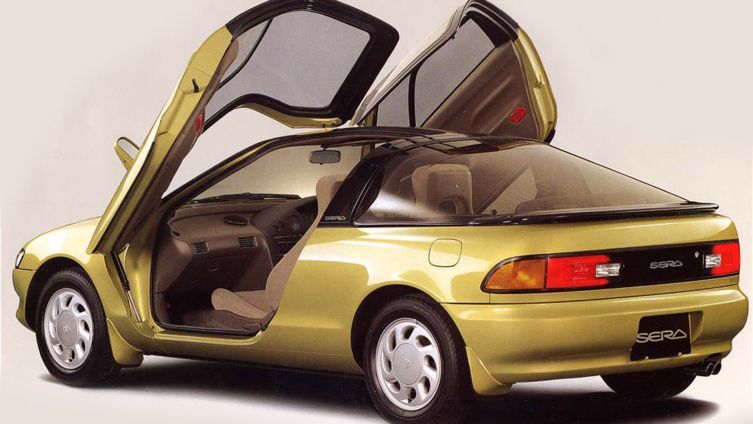
In a similar way, the sought-after Super Live Sound System option surrounded occupants in one of the most radical audio systems Toyota has ever engineered. This factory-fit system consisted of an array of ten speakers, including an acoustic resonance woofer in the boot and a newly developed, three-mode digital signal processor. It was also possible to rotate the rear deck speakers to bounce sound waves off the glass and create an alternate audio image.
The Sera was powered by the largest displacement engine from Toyota’s efficient four-cylinder E-series range. Known as the 5E-FHE, this newly developed, second-generation unit offered 1,496cc and a twin cam, 16-valve layout with high compression pistons and a relatively lofty 7,900rpm redline. Its sophisticated tuning and management allowed the 5E-FHE to balance strong levels of torque at low to medium engine speeds, with the enthusiasm of a sporty twin cam engine at higher revs.
These qualities were complimented by a newly designed suspension system and a wide wheel track (equal on both sides) that delivered the responses, stability and comfort that drivers might have expected from a coupe model. From the factory, all Sera models were equipped with high-performance tyres with asymmetrical and unidirectional tread patterns. Power steering was fitted as standard, although a four-wheel anti-lock brake system was optional.

Almost one year after the start of production, the Sera received the prestigious 1991 Torino-Piemonte Car Design Award for production cars, widely regarded as the top award in auto design. The Sera received high marks from all eleven jurors and was particularly praised for its balance of high-tech style and practicality that made the vehicle such a sales hit among first-time buyers.
Just under 16,000 Toyota Sera models were made from the start of production in February 1990, and all were destined for the Japanese domestic market. Three quarters of the cars were made and sold in the first phase of production, while the two subsequent phases only tweaked minor elements to keep the Sera looking fresh. However, by the start of phase two, the Japanese economy was already in steep decline, and phase three arrived after the bubble had burst. As a result, it was felt that the optimism and decadence wrapped up in the futuristic Toyota Sera had run its course, and production concluded in December 1995.

Since then, the Sera has become a firm favourite with importers – initially within right-hand drive markets such as the UK, but more recently in North American countries, where vehicles become straightforward to import and register after they reach 15-25 years old. The oldest examples of the Sera are now 30 years old and are being discovered, appreciated and restored by a new generation of Toyota enthusiasts.
Toyota Sera specifications
| DIMENSIONS | 3860mm (length), 1650mm (width), 1265mm (height) |
| WHEELBASE | 2300mm |
| TRACK | 1405mm (front), 1405mm (rear) |
| KERB WEIGHT (manual) | 890kg (+10kg with ABS, +20kg with Super Live Sound System) |
| KERB WEIGHT (automatic) | 930kg (+10kg with ABS, +20kg with Super Live Sound System) |
| ENGINE | 5E-FHE 1496cc four-cylinder DOHC with 9.8:1 compression |
| TRANSMISSION | C155 five-speed manual or A242L four-speed automatic |
| POWER | 108bhp at 6400rpm, 132Nm at 5200rpm |
| FUEL ECONOMY | 41.2mpg (manual), 33.9mpg (automatic) |
| FUEL TANK | 40 litres |
| STEERING | Rack and pinion |
| SUSPENSION (front) | MacPherson struts with coil springs, anti-roll bar |
| SUSPENSION (rear) | Torsion beam with coil springs, anti-roll bar |
| BRAKES (front) | Ventilated discs |
| BRAKES (rear) | Drums (leading/trailing design) or discs (with optional ABS) |
Learn more: History of the Toyota Starlet
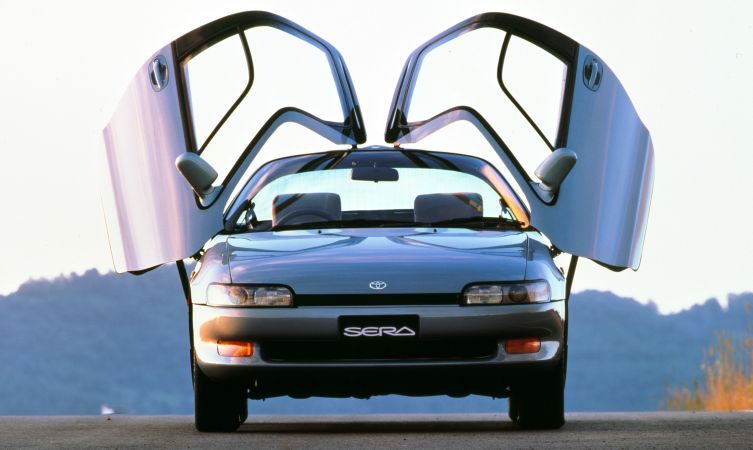




What a fantastic car then and now TOYOTA IS SO FORWARD WITH ITS DESIGN / INAVATION this car would be a great HYBRID❤️😀
Hi Kenn,
Thanks for getting in touch. We don’t blame you for loving the Toyota Sera – it is truly a unique car. It would be interesting to see it in a modern environment!
We know it’s not the same, but have you seen our all-new Yaris? It’s a hybrid as well!
You can explore the Yaris, here: https://mag.toyota.co.uk/introducing-new-toyota-yaris
Thanks.
Minor typo. Torque is generally expressed as a mass multiplied by a distance, and if you remeber algebra from school, multiplication can be expressed by a . rather than an x which gets confused when dealing with x and y. Hence torque is generally lb.ft or m.kg
Hi Andrew,
Thanks for your comment. We’re glad that you’ve enjoyed reading our blog so closely!
From a scientific perspective, you are indeed correct. However, where possible, we use Newton Metres for our torque measurements, and this has now been converted to reflect this.
Thanks.
Great write up. I got mine in the US in January 2021, and am loving it. I wish Toyota would do something like Honda is doing for the Beat, and start manufacturing parts again for the Sera. Maybe ship some of them to a warehouse in North America for Toyota Dealerships to be able to get parts from.
Hi Todd,
Thanks for your comment.
We would recommend sending your query to Toyota USA for questions specific to the American market.
Thanks.
Hi, I have just come across my first sighting of the Sera… what a wonderful concept and the design still looks fresh. have you any idea what the co2 figures would be for this car…
Kind regards
K.B.
Hi Ken,
Thanks for your kind words!
As the Sera was never officially sold in the UK market, we do not have this information available.
Thanks.
I own one of these amazing cars which has been off the road for several years. Currently repairing it to drive in London and would like to know if these cars meet the UK Ultra Low Emission Zone (ULEZ) standard . DVLA said it not , unless I can prove that it does. ULEZ criteria’s are:
a. Emit no more than 50g/km C02 and. E capable of being operated with no (zero) exhaust emissions for a minimum range of 10 miles (16.093km): or
b. Emits no more than 75g/km CO2 exhaust emissions and be capable of being operated with no (Zero) emissions for a minimum range of 20 miles (32.187km).
The Toyota Sera cars are configured with electronic fiscal injection so I was wondering if there could be an exemption criteria. However, I do not know what the CO2 emissions is. It is not shown on the V5C document. Do you know what it is or where I can get this information?
As a minimum the vehicle must meet Euro 6 emission standards if an internal combustion engine is part of the vehicle specification (I.e.hybrid vehicle)
Hi Viv,
Please email your VIN number to toyota.blog@tgb.toyota.co.uk so we can look into this for you.
Be advised that there is no guarantee of finding the information as it is a non European vehicle.
Thanks.
Viv I’m not sure why you are asking these questions to Toyota Uk…
ULEZ points a and b that you quoted clearly state that the vehicle must be able to run emissions-free for certain distances, which (without an electric motor) the Sera obviously can’t.
The Sera also obviously wont be Euro 6 Certified because 1) it was long out of production before such rules came into place and 2) it was never officially imported to the EU so there’d be no reason for Toyota to have subjected it to the Euro 6 tests even if it was in production at that time.
If you live in a London ULEZ I’d drag that restoration out for another 10 years or so and wait for the car to reach Historic status and thus be free from emissions restrictions (assuming the Govt doesn’t backtrack on the 40 year rule in the meantime!).
I am currently having my Sera restored and desperately require an air con condenser.
As you know you cannot drive it in the summer without air con!
Does anyone know if the condenser was specific to the Sera or whether it was shared with other Toyota models?
Many thanks
Hi Glenn, thanks for your comment.
You can look here for our Toyota Genuine Parts: https://www.toyota.co.uk/owners/parts-accessories/parts.
Thanks.
I’ve just seen one of these beautiful little cars parked up here in North Herts (UK).
I’ve never seen one before.
Styling so agreeable compared to present day angular aggressive designs.
It looks very practical too.
It’s hard to believe it is 35 years old.
A shame we won’t be meeting more on the roads.
Hi Andrew,
Thank you very much for this message. It’s always great to hear continuous positive feedback about our cars.
For more information about new releases: https://mag.toyota.co.uk/
Many thanks,
Toyota UK
Dear Toyota,
My name is Ross and I am currently in the research stage of producing a book all about the Toyota Sera, and I am also in the process of making some videos about it for YouTube.
I have been obsessed with this little car since 1999 when I acquired my first one. I have owned 5 of them to date, and still have two of them here in my garage.
I would love to know more about the car (I already know quite a bit), and in particular I would love to speak to someone about the design and development of the car. Does Toyota employ any historians who I could speak to about this car that has defined much of my life? Any help would be much appreciated.
Kind regards,
Ross
Good morning Ross, apologies for the delay in coming back to you.
It’s great to hear of your love for the Toyota Sera. The online Magazine here is the best place for learning more. Regrettably, we don’t have anyone on hand to assist you further but we wish you all the best with your book and YouTube. Be sure to share with us in the future!
Thank you.
Hi,
Where can I find out more about the design team of the Toyota Sera? I have read that Stewart Reed was the lead designer, but information seems scarce.
Kind regards
Rosco
Good morning Rosco, apologies for the delay in coming back to you.
It’s great to hear of your love for the Toyota Sera. The online Magazine here is the best place for learning more. Wishing you all the best for the future!
Thank you.